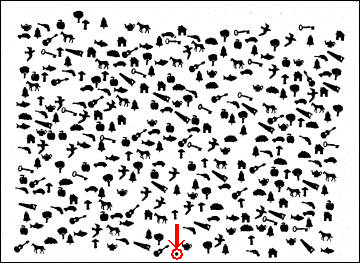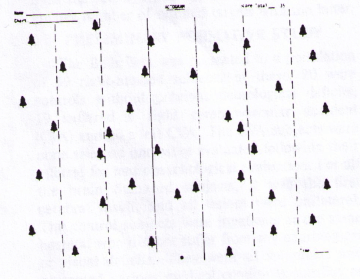Bells Test
Purpose
The Bells Test is a cancellation test that allows for a quantitative and qualitative assessment of visual neglect in the near extra personal space.
In-Depth Review
Purpose of the measure
The Bells Test is a cancellation test that allows for a quantitative and qualitative assessment of visual neglect in the near extrapersonal space.
Available versions
The Bells Test was developed by Gauthier, Dehaut, and Joanette in 1989.
Features of the measure
Items:
There are no actual items to the Bells Test.
In the Bells Test, the patient is asked to circle with a pencil all 35 bells embedded within 280 distractors (houses, horses, etc.) on an 11 x 8.5 – inch page (Figure 1). All drawings are black. The page is placed at the patient’s midline.
Figure 1. Bells Test

The objects are presented in an apparently random order, but are actually equally distributed in 7 columns containing 5 targets and 40 distractors each. There is a black dot on the bottom of the page to indicate where the page should be placed in relation to the patient’s midsaggital plane. Of the 7 columns, 3 are on the left side of the sheet, 1 is in the middle, and 3 are on the right. Therefore, if the patient omits to circle bells in the last column on the left, we can estimate their neglect is mild. However, omissions in the more centered columns can suggest a greater neglect of the left side of space.
The examiner is seated facing the patient. First a demonstration sheet is presented to the patient. This sheet contains an oversized version of each of the distractors and one circled bell. The patient is asked to name the images indicated by the examiner in order to ensure proper object recognition. If the patient experiences language difficulties or if the examiner suspects comprehension problems, the patient can instead place a card representing that object over the actual image.
The examiner gives the following instructions: “Your task will consist of circling with the pencil all the bells that you will find on the sheet that I will place in front of you without losing time. You will start when I say “go” and stop when you feel you have circled all the bells. I will also ask you to avoid moving or bending your trunk if possible.” If a comprehension problem is present, the examiner has to demonstrate the task.
The test is then placed in front of the patient with the black dot (see arrow on Figure 1) on the subject’s side, centered on his midsagittal plane (divides the body into right and left halves). The test sheet is given after the instructions.
The examiner holds the scoring sheet (Figure 2) away from the patient’s view, making sure the middle dot is towards the patient. This upside-down position will make scoring easier for the examiner. After the patient begins the test, the examiner records the order of the bells circled by the patient by numbering the order on his/her scoring sheet (e.g. 1, 2, 3,…). If the patient circles another image (an image that is not a bell), the examiner indicates on his/her scoring sheet the appropriate number and the approximate location. The subsequent bell receives the next number.
Figure 2. Examiner scoring sheet.

If the patient stops before all the bells are circled, the examiner gives only one warning by saying “are you sure all the bells are now circled? Verify again.” After that, the order of numbering continues, but the numbers are circled or underlined. The task is completed when the patient stops his/her activity.
Scoring:
The total number of circled bells is recorded as well as the time taken to complete. The maximum score is 35. An omission of 6 or more bells on the right or left half of the page indicates USN. Judging by the spatial distribution of the omitted targets, the evaluator can then determine the severity of the visual neglect and the hemispace affected (i.e. left or right).
The sequence by which the patient proceeds during the scanning task can be determined by connecting the bells of the scoring sheet according to the order of the numbering.
Time:
Less than 5 minutes.
Training:
None typically reported.
Subscales:
None.
Equipment:
- The test paper (8.5″x11″ page with 35 bells embedded within 280 distractors).
- Pencil
- Score sheet
- Stopwatch
Alternative forms of the Bell’s Test
None.
Client suitability
Can be used with:
Patients with stroke
- Patients must be able to hold a pencil to complete the test (the presence of apraxia may impair this ability).
- Patients must be able to visually discriminate between distractor items, such as the images of houses and horses, and the bells that are to be cancelled.
Should not be used with:
- As with other cancellation tests, the Bells Test cannot be used to differentiate between sensory neglect and motor neglect because it requires both visual search and manual exploration (LÀdavas, 1994).
- The Bells Test cannot be completed by proxy.
In what languages is the measure available?
Not applicable.
Summary
| What does the tool measure? | Unilateral Spatial Neglect (USN) in the near extra personal space. |
| What types of clients can the tool be used for? | Patients with stroke |
| Is this a screening or assessment tool? |
Screening . |
| Time to administer | Less than 5 minutes. |
| Versions | None. |
| Other Languages | Not applicable. |
| Measurement Properties | |
| Reliability |
Internal consistency No studies have examined the internal consistency Test-retest: |
| Validity |
Criterion: One study reported that the Bells Test is more likely to identify the presence of neglect than the Albert’s Test in patients with stroke Construct: |
| Does the tool detect change in patients? | Not applicable. |
| Acceptability | The Bells Test should be used as a screening tool rather than for clinical diagnosis of USN. Apraxia must be ruled out as this may affect the validity of test results. This test cannot be completed by proxy. Patients must be able to hold a pencil and visually discriminate between distractor items to complete. The measure cannot be used to differentiate between sensory neglect and motor neglect. |
| Feasibility | The Bells Test requires no specialized training to administer and only minimal equipment is required (a pencil, a stopwatch, the test paper and scoring sheet). The test is simple to score and interpret. The test is placed at the patient’s midline and a demonstration sheet is used to familiarize the patient with the images used in the test. The examiner is required to follow along with the patient as they circle each bell, and record on the scoring sheet the order in which the bells are cancelled. Upon completion of the test, the examiner must count the number of bells cancelled out of a total of 35, and record the time taken by the patient. An omission of 6 or more bells on the right or left half of the page indicates USN. |
| How to obtain the tool? |
You can download a copy: Bell’s Test
|
Psychometric Properties
Overview
A review of the Bells Test reported that the measure has excellent test-retest reliability
than Line Bisection Test (Marsh & Kersel, 1993; Azouvi et al., 2002).
For the purposes of this review, we conducted a literature search to identify all relevant publications on the psychometric properties of the Bells Test.
Reliability
Internal consistency
No studies have examined the internal consistency
Test-retest:
No studies have examined the test-retest reliability
of the Bells Test.
Validity
Criterion:
Vanier et al. (1990) administered the Bells Test and the Albert’s Test to 40 neurologically healthy adults, and 47 patients with right brain stroke
Ferber and Karnath (2001) examined the ability of various cancellation and line bisection tests to detect the presence of neglect in 35 patients with spatial neglect. The Bells Test detected a significantly higher percentage of omitted targets than the other tests (Line Bisection Test, and 3 cancellation tests: Letter Cancellation Test, Star Cancellation Test and Line Crossing Test). The Line Bisection Test missed 40% of patients with spatial neglect. The Letter Cancellation Test and the Bells Test missed only 6% of the cases.
Construct:
Known groups:
Gauthier et al. (1989) examined the Bells Test in 59 subjects, of which 20 were controls, 19 had right cerebral lesions and 20 had left cerebral lesions. A statistically significant difference in mean scores between the group with right cerebral lesions and the group with left cerebral lesions was observed.
Responsiveness
No studies have examined the responsiveness
of the Bells Test.
References
- Azouvi, P., Samuel, C., Louis-Dreyfus, A., et al. (2002). Sensitivity of clinical and behavioural tests of spatial neglect after right hemisphere stroke. J Neurol Neurosurg Psychiatry, 73, 160 -166.
- Ferber, S., Karnath, H. O. (2001). How to assess spatial neglect–Line Bisection or Cancellation Tests? J Clin Expl Neuropsychol, 23, 599-607.
- Gauthier, L., Dehaut, F., Joanette, Y. (1989). The Bells Test: a quantitative and qualitative test for visual neglect. Int J Clin Neuropsychol, 11, 49-54.
- LÃ davas, E. (1994). The role of visual attention in neglect: A dissociation between perceptual and directional motor neglect. Neuropsychological Rehabilitation, 4, 155-159.
- Marsh, N. V., Kersel, D. A. (1993). Screening tests for visual neglect following stroke. Neuropsychological Rehabilitation, 3, 245-257.
- Menon, A., Korner-Bitensky, N. (2004). Evaluating unilateral spatial neglect post stroke: Working your way through the maze of assessment choices. Topics in Stroke Rehabilitation, 11(3), 41-66.
- Vanier, M., et al. (1994). Evaluation of left visuospatial neglect: norms and discrimination power of the two tests. Neuropsychologia, 4, 87-96.
See the measure
How to obtain the Bell’s Test
You can download